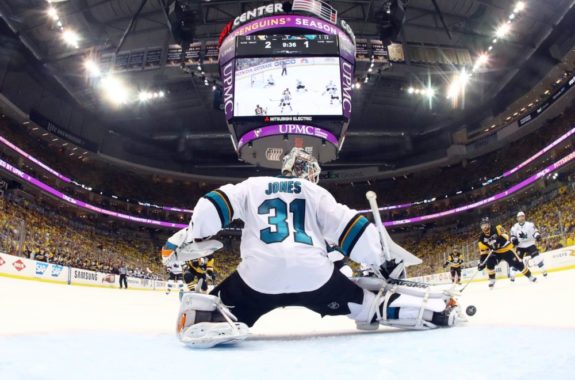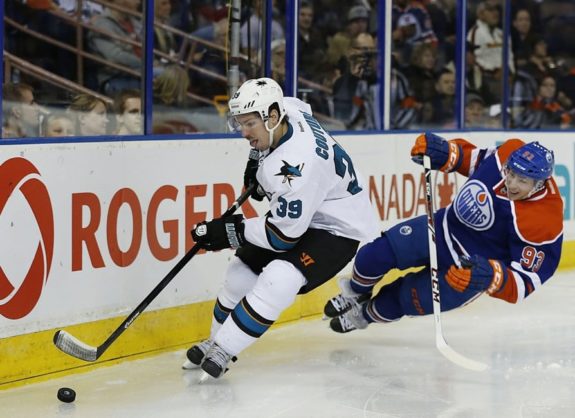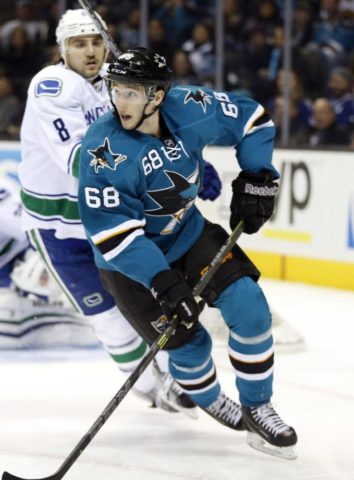It is early in the NHL season and the San Jose Sharks sit with a modest 4-4-0 record. While the first two games of the season were not good, the Sharks have been strong since then. In most of these six games, the Sharks have either matched or outplayed their opponents.
What has been working? For starters, special teams. While the eyeballs report the top unit power play remains a problem, the second unit has been much more effective and the result is seven goals in eight games. The penalty kill has also been effective. After an opening night disaster, the unit has given up just a single goal in the last seven games. Since the opener, the Sharks have won the special teams goal scoring, 5-1, despite being shorthanded six more times than opponents during this stretch.

Similarly, the goaltending has been good. Martin Jones had two abysmal games to start the season, but Jones and backup Aaron Dell (two starts) have combined for stellar a .927 save percentage in the last six. The Sharks have also outshot their opponents during this stretch by 4.5 shots per game.
It’s fair to say, much is working; an honest assessment of the Sharks finds plenty of positives.
The Missing Element
One negative, though, is even strength scoring. The team has 15 even strength goals in eight games, which isn’t enough. Yet, the Sharks haven’t struggled with possession. They haven’t struggled with holding onto the puck. They haven’t struggled in getting shots on net. What gives?
A situation where many teams get high percentage scoring chances is the quick strike. Situations like odd-man rushes and turnovers give teams the chance for “early offense” – scoring opportunities which occur before the defense sets up. This is increasingly important to a successful team.
It is tough to score if an NHL defense gets set. Teams attempt to grind and cycle, but the formula for keeping the puck out of the net is known across the league. Keep good defensive position to force the puck to the outside. Tie up forwards in front of the net and keep sticks in passing lanes, especially the cross-ice passing lanes. Do these few things defensively and it is tough for the other team to score. An even-strength offense can dominate puck possession, but this doesn’t always equate to scoring.
A New York Contrast
The Sharks were missing an effective quick-strike transition game through their first seven games, including their loss to the New York Islanders on Saturday. They found a quick-strike offense, really for the first time this season, in their game against the New York Rangers on Monday.
The two games in New York provide good a contrast.
In Brooklyn
In the Saturday game against the Islanders, San Jose got three goals from Logan Couture. His first goal came on the power play. He redirected a Brent Burns wrister from the high slot. The third goal, during 6-on-5 play, was a greasy goal, the result of a battle in front of the net. The middle goal is what the Sharks need more often. It came on a terrific snipe, scored on a 3-on-3 rush before the Isles defense was able to set up. This Couture goal came two seconds after the puck entered the offensive zone.

The Islanders scored four even-strength goals (their fifth went into an empty net) against San Jose. All four came on quick strikes before the defense could properly set up. Two Isles scores came on turnovers, one goal three seconds after the turnover, the other seven seconds after the turnover. Two scores came on rushes, one goal three seconds after zone entry, the other six seconds after zone entry. There was little passing and no offensive set-up. On each goal, three or fewer Isles touched the puck in the offensive zone.
In terms of quick strikes, the Isles won the battle 4-1. They won the game 5-3, even though the Sharks had eight more shots on goal.
In Manhattan

Two nights later against the New York Rangers, the script flipped.
In this game, three of the Sharks four scores came on quick strikes. The opening goal came during a delayed penalty with the Sharks skating 6-on-5. The next three all came within four seconds of zone entry. Joonas Donskoi scored on a breakaway (three seconds in the offensive zone). Melker Karlsson scored off his own dump in. Rangers goalie Henrik Lundqvist misplayed the puck, Logan Couture stole it from him and immediately fed Karlsson (four seconds in the offensive zone). Tim Heed earned his first NHL goal when he carried the puck into the offensive zone, skated down the wall and sent a bad angle shot through Lundqvist (two seconds in the offensive zone).
In terms of quick strikes, the Sharks won the battle 3-0. They won the game 4-1, even though the Rangers had ten more shots on goal.
Going Forward
In San Jose’s two New York City games, 13 goals were scored. Three were scored in 6-on-5 situations, a fourth came on a power play. Nine goals were scored during 5-on-5 play. Of the nine, how many were quick-strike goals? At least eight, possibly all nine. Of the eight, the longest offensive possession was seven seconds. Only the lone Rangers goal came against a set defense, and even this goal came moments after a San Jose turned the puck over while attempting a clear.
While these two games represent a very limited sample, they illustrate the importance of quick-strike scores to winning hockey. The high-percentage shots generated with early offense are a significant portion of the scoring in today’s NHL.
Quick-strike scoring is San Jose’s missing link, at least until the game against the Rangers. Is the performance against the Rangers is a sign of positive things to come or merely an aberration against a struggling team? This is something we find out as the season moves forward.
The Sharks can ride a productive power play, solid penalty killing, good defense and effective goaltending to playoff contention. But, for San Jose to become one of the league’s best teams, they need quick-strike scores as part of their repertoire.
Zeke’s Notes
Brent Burns is off to a problematic start. One number, minus-7, is particularly dramatic. I’d argue this number exaggerates Burns defensive problem (his minus-4 against the Los Angeles Kings, for example, was mostly on others), but he hasn’t been good either.
One example is the Andrew Ladd goal for the Isles (at 2:01 on the video) which shows Burns double-teaming a player who didn’t need to be double teamed. This leads directly to the Isles score. Another example came against the Rangers, where Burns and Joel Ward lose a board battle against one Rangers player, leading directly to a Mika Zibanejad goal.

But the bigger Burns issue so far is the lack of even-strength scoring. Through eight games, Burns has just one point, an assist, scored at 5-on-5 (his other points are two power play assists and two 6-on-5 assists). More importantly, during his roughly 135 minutes of 5-on-5 ice time, the entire Sharks team has scored just two goals. With Burns on the ice, San Jose is scoring at about one-quarter the rate they did last season.
Burns does not need to score a lot to make the Sharks offense effective. If teams pay too much attention to Burns, it can open other areas of the ice for San Jose. So far this season, the Sharks 5-on-5 offense with Burns on the ice is not nearly productive enough.